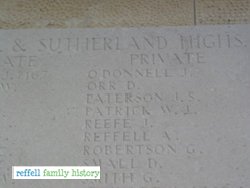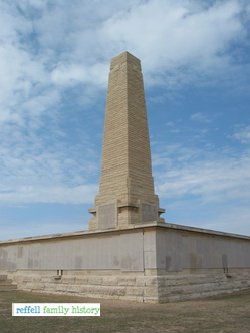1st/5th Battalion, Princess Louise’s (Argyll and Sutherland Highlanders)
Killed in action on Monday, 12th July 1915
Personal Information:
Alfred James Reffell was born 1 June 1896 at 6 Mardanlian Street, Greenock, Renfrewshire. He was the only son of William Alfred Reffell (1863-1898) & Annie Murray McKinnon (1868-1916). After his father’s death, his mother married Hugh McMillan Neill and there were two further sons; William 1904 and Charles 1906. Hugh Neill had a surviving daughter from an earlier marriage, Agnes McMillan who was born in 1896.
In the 1901 census he was in the Carnegie Orphanage, Kilmalcolm, Renfrewshire, and his mother is living with her sister at 73 Ann Street, Greenock. By 1911 he was living at 9 Hope Street with his mother and the two step brothers.
Alfred James enlisted using his first name only into the Territorial Army before the start of the war, at the age of 17 on the 11 February 1914 at Greenock; his occupation was given as an apprentice pattern maker with Scott & Co. He was unmarried.
Historical Information:
1/5th (Renfrewshire) Battalion Princess Louise’s (Argyll and Sutherland Highlanders)
1914
Drill Hall, Finnart Street, Greenock: attached to Black Watch Brigade, Army Troops.
Scottish Coast Defences.
1915
Scottish Coast Defences: attached to Black Watch Brigade, Army Troops.
24 April moved to HLI Brigade, Lowland Division at Dunfermline.
11 May formation became 157th Brigade, 52nd Lowland Division
1 June embarked at Devonport.
12 June arrived at Alexandria
1 July arrived at Mudros.
3 July landed at Cape Helles.
Alfred was involved in what became the last push of the Gallipoli campaign towards Krithia and indeed one of the final actions in the south part of the arena. It is also probable that he was fighting as far inland as any Tommy in the area. Such was the confused situation at the time that many bodies were not finally buried until sometime after the war, The whereabouts of Alfred’s last resting place, like 40% of all British dead here, is unknown. He was awarded the Victory Medal, the British War Medal and the 1914/15 Star.
From ‘Gallipoli’ by L A Carlyon, Bantam Books (2001)
‘The 52nd, Egerton’s Division, was in reasonable shape by Helles standards… So now it was the run of these two (battalions), the 155th and the 157th, neither of which had been in an assault before. They would attack east of the Krithia Road. The French would attack to their right. The 155th would go over the top at 7.35am and the 157th at 4.50pm. This way the artillery could use all its guns to support one brigade at a time.
So now, on July 12, the men of the 155th, wearing the heavy serge uniforms that they had brought from England, went forth in the fierce sun to make their sacrifice to Achi Baba. The battle went to the Helles rituals. The (155th) brigade found the Turkish frontline trenches easily enough. These were thick with Turks killed in the bombardment and splashed with blood. Some battalions appear to have overrun their objectives. One of these, left out in the open, quickly lost 60 per cent of its men… It was chaos, also part of the Helles ritual. No-one behind the lines knew what trenches had been taken and where the various battalions were. Even at noon Hunter-Weston didn’t know what was happening. He finally decided that the afternoon attack by the other brigade would go ahead.
The 157th captured the enemy’s front and support trenches, but was cut down when it reached the third line, which was only 18 inches deep. By nightfall the battlefield was still confused. Those of the 52nd Division still alive were desperately thirsty and lying in gore-splashed trenches next to the bodies of Turks and Englishmen swollen by the sun. The frontline was a scene from some Dantesque hell.’
Memorial:
Panel 183 Helles Memorial, Gallipoli, Turkey.


The Helles Memorial serves the dual function of Commonwealth battle memorial for the whole of the Gallipoli campaign and is also the place of commemoration for many of those Commonwealth servicemen who died there and have no known grave.
The United Kingdom and Indian forces named on the memorial died in operations throughout the peninsula, and there are also those Australians who died in the Helles area.
There are also panels for those who died or were buried at sea in Gallipoli waters. The memorial bears more than 21,000 names.
Many thanks go to Colonel Christopher Newbould CBE and Poppy Travel for arranging the visit to Gallipoli.